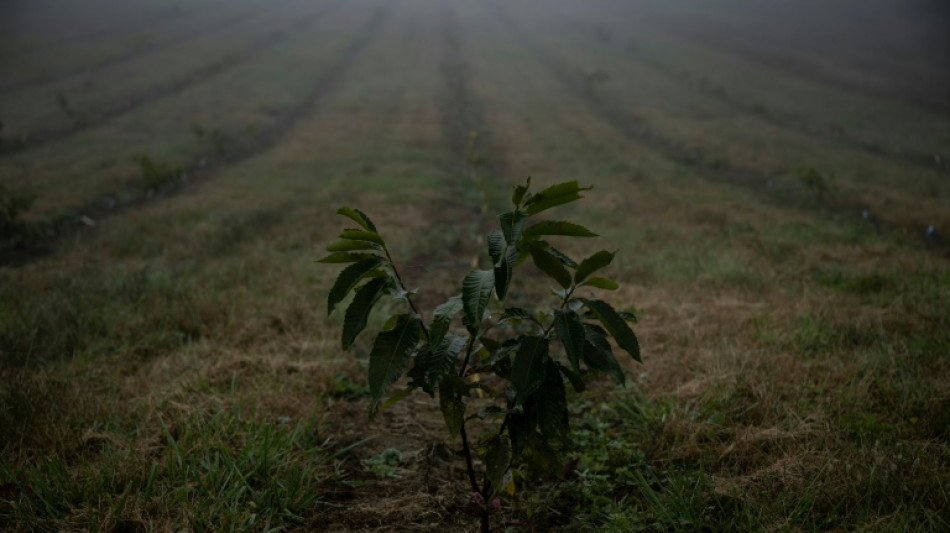
-
 Fleeing Pakistan, Afghans rebuild from nothing
Fleeing Pakistan, Afghans rebuild from nothing
-
US Supreme Court to hear case against LGBTQ books in schools

-
 Pistons snap NBA playoff skid, vintage Leonard leads Clippers
Pistons snap NBA playoff skid, vintage Leonard leads Clippers
-
Migrants mourn pope who fought for their rights
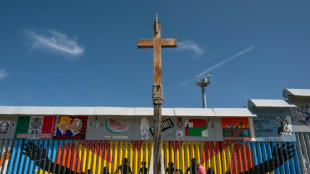
-
 Duplantis kicks off Diamond League amid Johnson-led changing landscape
Duplantis kicks off Diamond League amid Johnson-led changing landscape
-
Taliban change tune towards Afghan heritage sites
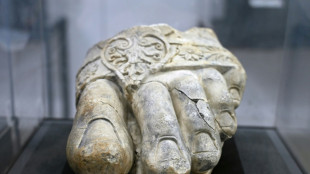
-
 Kosovo's 'hidden Catholics' baptised as Pope Francis mourned
Kosovo's 'hidden Catholics' baptised as Pope Francis mourned
-
Global warming is a security threat and armies must adapt: experts

-
 Can Europe's richest family turn Paris into a city of football rivals?
Can Europe's richest family turn Paris into a city of football rivals?
-
Climate campaigners praise a cool pope

-
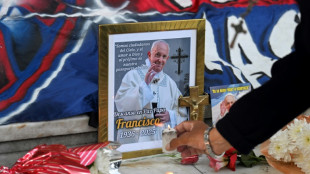 As world mourns, cardinals prepare pope's funeral
As world mourns, cardinals prepare pope's funeral
-
US to impose new duties on solar imports from Southeast Asia

-
 Draft NZ law seeks 'biological' definition of man, woman
Draft NZ law seeks 'biological' definition of man, woman
-
Auto Shanghai to showcase electric competition at sector's new frontier

-
 Tentative tree planting 'decades overdue' in sweltering Athens
Tentative tree planting 'decades overdue' in sweltering Athens
-
Indonesia food plan risks 'world's largest' deforestation
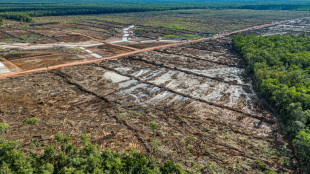
-
 Gold hits record, stocks slip as Trump fuels Fed fears
Gold hits record, stocks slip as Trump fuels Fed fears
-
Trump helps enflame anti-LGBTQ feeling from Hungary to Romania
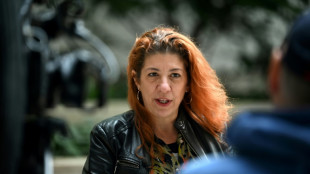
-
 Woe is the pinata, a casualty of Trump trade war
Woe is the pinata, a casualty of Trump trade war
-
'Like orphans': Argentina mourns loss of papal son

-
 Trump tariffs torch chances of meeting with China's Xi
Trump tariffs torch chances of meeting with China's Xi
-
X rival Bluesky adds blue checks for trusted accounts

-
 China to launch new crewed mission into space this week
China to launch new crewed mission into space this week
-
Morocco volunteers on Sahara clean-up mission

-
 Latin America fondly farewells its first pontiff
Latin America fondly farewells its first pontiff
-
'I wanted it to work': Ukrainians disappointed by Easter truce

-
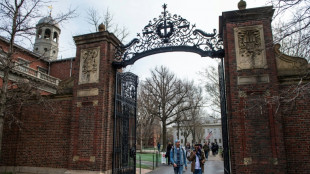 Harvard sues Trump over US federal funding cuts
Harvard sues Trump over US federal funding cuts
-
'One isn't born a saint': School nuns remember Pope Francis as a boy

-
 Battling Forest see off Spurs to boost Champions League hopes
Battling Forest see off Spurs to boost Champions League hopes
-
'I don't miss tennis' says Nadal

-
 Biles 'not so sure' about competing at Los Angeles Olympics
Biles 'not so sure' about competing at Los Angeles Olympics
-
Gang-ravaged Haiti nearing 'point of no return', UN warns

-
 US assets slump again as Trump sharpens attack on Fed chief
US assets slump again as Trump sharpens attack on Fed chief
-
Forest see off Spurs to boost Champions League hopes

-
 Trump says Pope Francis 'loved the world,' will attend funeral
Trump says Pope Francis 'loved the world,' will attend funeral
-
Oscar voters required to view all films before casting ballots

-
 Bucks' Lillard upgraded to 'questionable' for game 2 v Pacers
Bucks' Lillard upgraded to 'questionable' for game 2 v Pacers
-
Duplantis and Biles win Laureus World Sports Awards

-
 US urges curb of Google's search dominance as AI looms
US urges curb of Google's search dominance as AI looms
-
The Pope with 'two left feet' who loved the 'beautiful game'

-
 With Pope Francis death, Trump loses top moral critic
With Pope Francis death, Trump loses top moral critic
-
Mourning Americans contrast Trump approach to late Pope Francis

-
 Leeds and Burnley promoted to Premier League
Leeds and Burnley promoted to Premier League
-
Racist gunman jailed for life over US supermarket massacre

-
 Trump backs Pentagon chief despite new Signal chat scandal
Trump backs Pentagon chief despite new Signal chat scandal
-
Macron vows to step up reconstruction in cyclone-hit Mayotte

-
 Gill, Sudharsan help toppers Gujarat boss Kolkata in IPL
Gill, Sudharsan help toppers Gujarat boss Kolkata in IPL
-
Messi, San Lorenzo bid farewell to football fan Pope Francis

-
 Leeds on brink of Premier League promotion after smashing Stoke
Leeds on brink of Premier League promotion after smashing Stoke
-
In Lourdes, Catholic pilgrims mourn the 'pope of the poor'


For blight-ridden American chestnut tree, rebirth may be in offing
The American chestnut tree, once a regal pillar of forests across the eastern United States, is on life support, struggling to survive.
"These look like death," said Vasiliy Lakoba, research director for the American Chestnut Foundation (ACF), which has been working since the 1980s to resurrect the species.
He pointed to a patch of stunted shrubs, chestnut trees that were a far cry from the noble, erect chestnut trees of yesteryear.
Settlers along the US eastern seaboard relied on abundant chestnut trees to feed their hogs, their children and themselves. Chestnuts made up about 50 percent of hardwood forests in much of the eastern seaboard, and the wood was ideal for building.
But then came a terrible fungus, identified in 1904 at the Bronx Zoo on a tree from Japan. In less than three decades, millions of American chestnut trees had perished. It has been considered the greatest tragedy in the history of American forestry.
"The devastation was so fast," said Lakoba, referring to "ghost forests."
Today, only a few rare specimens still survive to adulthood in the wild.
- 'Tall and straight' -
Nestled in the Appalachian Mountains, the foundation's main laboratory farm spans 36 hectares (almost 90 acres) in Virginia and includes tens of thousands of trees.
Workers use a crane to harvest the burrs, or spiny prickly shells that cover the nuts, then take them to a shed to be studied and used for future planting.
"It's like picking apples, but with pricks," laughed Jim Tolton, a technician on the farm, during a chestnut harvest day in early October.
Before the disease, the American chestnut tree "grew tall and straight through the forest, fighting for light," Lakoba said.
But the blight causes cankers to appear on the branches and stems of the American chestnut tree.
Blighted trees grow other branches here and there, giving them a bushy appearance, instead of maintaining a tall, straight shape.
No cure has yet been found to stop the spread.
- Hybrids and GMOs -
Finding a way to fight the blight is precisely the mission of ACF.
To do this, two main research avenues are under investigation: The first, which has been in place for years, consists of crossing an American chestnut tree with other species that already show some resistance to the fungus, such as the Chinese chestnut tree.
A first specimen is produced from this hybridization, before it is crossbred again with an American chestnut tree, then once again -- all in order to preserve as much of the original genetic characteristics as possible. The current hybrid has 15/16ths of the genetic makeup of an American chestnut tree -- while ideally acquiring the resistance of the Chinese chestnut tree.
One of the main drawbacks with these hybrids, explained Lakoba, "is that blight resistance and susceptibility have turned out to be a genetically much more complex phenomenon than previously thought."
ACF researchers have not abandoned their crossbreeding efforts. But a second avenue of research has opened up: genetic modification.
Working on a transgenic version of the American chestnut tree, researchers at the State University of New York at Syracuse have developed a specimen that shows very promising early results of disease resistance, according to Lakoba, who is collaborating with the researchers.
Combining crossbreeding with genetic modification might yield better results, he said.
- 'Keep chipping away' -
Once a resistant specimen has been developed, the time will come for the Herculean task of reintroducing the tree to an American landscape deeply altered by more than a century of development.
"So much has changed in terms of climate, in terms of invasive species, in terms of pollution, habitat change, land use, change, soil loss and erosion, that it really isn't the same world from 100 years ago," Lakoba said.
Not only has the landscape been altered, Lakoba said, climate change adds another wildcard to whether the American chestnut can ever prosper again.
"Overall, there will be more pests, there will be more diseases," he said.
Any revival of the American chestnut may be decades -- or centuries -- away.
"This is definitely at least a couple centuries of a mission going forward. And from there, I think we just keep chipping away at it," Lakoba said.
But he is hopeful that scientific advances are on the side of the American chestnut.
"We see it really as a matter of time."
K.Brown--BTB


